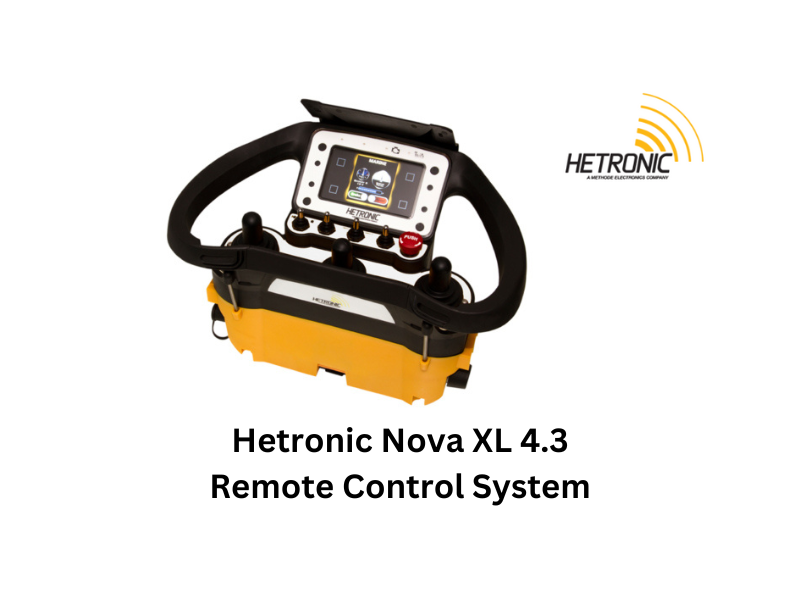Introduction – Industrial Radio Remote Controls
The industrial sector is on the brink of a technological revolution, and radio remote controls are at the forefront of this transformation. As we hurtle towards an increasingly connected and automated future, these unassuming devices are evolving into powerful tools that promise to reshape how we interact with machinery and processes. From enhanced safety features to integration with cutting-edge technologies, the landscape of industrial radio remote controls is changing rapidly.
In this comprehensive guide, we’ll explore the 10 most exciting future trends that are set to redefine radio remote controls in the industrial sector. Whether you’re a seasoned industry professional or a curious newcomer, understanding these innovations will be crucial for staying ahead of the curve and maximizing efficiency in your operations.
So, buckle up and get ready to dive into the future of industrial control – it’s closer than you think!
1. AI-Powered Predictive Maintenance
Artificial Intelligence (AI) is making its mark across industries, and radio remote controls are no exception. One of the most promising applications of AI in this field is predictive maintenance. Future remote controls will be equipped with sophisticated sensors and machine learning algorithms that can analyze patterns in equipment performance and usage.
These smart devices will be able to:
– Detect early signs of wear and tear
– Predict potential failures before they occur
– Schedule maintenance activities proactively
By implementing AI-powered predictive maintenance, industries can:
– Reduce downtime by up to 50%
– Extend equipment lifespan by 20-40%
– Cut maintenance costs by 10-40%
Imagine operating a crane in a bustling construction site. Your radio remote control suddenly alerts you that the hydraulic system is showing signs of strain and recommends a maintenance check within the next 48 hours. This early warning could prevent a catastrophic failure, saving both time and money while ensuring worker safety.
2. 5G Integration for Ultra-Low Latency Control
The rollout of 5G networks is set to revolutionize industrial radio remote controls. With speeds up to 100 times faster than 4G and latency as low as 1 millisecond, 5G technology will enable near-instantaneous response times between the operator and the controlled equipment.
Benefits of 5G integration include:
– Real-time control of high-precision machinery
– Seamless operation of multiple devices simultaneously
– Enhanced reliability in areas with high electromagnetic interference
According to a recent industry report, 72% of manufacturing executives believe 5G will be a key enabler of their digital transformation within the next five years. This technology will be particularly crucial for applications requiring split-second decisions, such as robotic surgery or autonomous vehicle control in mining operations.
3. Augmented Reality (AR) Interfaces
Augmented Reality is poised to transform the way operators interact with radio remote controls. By overlaying digital information onto the physical world, AR interfaces will provide operators with real-time data and visual guidance, enhancing both efficiency and safety.
Key features of AR-enabled remote controls:
– Heads-up displays showing equipment status and performance metrics
– Virtual markers highlighting safe operating zones and potential hazards
– Step-by-step visual instructions for complex procedures
A survey of early adopters found that AR interfaces in industrial settings led to:
– 25% reduction in errors
– 30% increase in task completion speed
– 40% improvement in first-time fix rates for maintenance tasks
Picture a warehouse operator using an AR-enabled remote control to guide an automated forklift. The AR interface highlights the optimal path, avoiding obstacles and other workers, while providing real-time inventory updates as items are moved.
4. Biometric Authentication for Enhanced Security
As industrial processes become more automated and interconnected, security becomes paramount. Future radio remote controls will incorporate advanced biometric authentication methods to ensure that only authorized personnel can operate critical machinery.
Potential biometric features include:
– Fingerprint scanners
– Facial recognition
– Voice authentication
– Retinal scanning
By implementing biometric security measures, industries can:
– Reduce the risk of unauthorized access by up to 90%
– Improve compliance with safety regulations
– Create detailed audit trails of equipment usage
This technology will be particularly valuable in high-risk environments such as nuclear power plants or chemical processing facilities, where strict access control is essential for safety and security.
5. Haptic Feedback for Improved Operator Awareness
Touch is a powerful sense, and future radio remote controls will leverage it to enhance operator awareness and control precision. Advanced haptic feedback systems will provide tactile sensations that correspond to the actions and status of the controlled equipment.
Benefits of haptic feedback include:
– Improved situational awareness without constant visual focus
– Enhanced precision in delicate operations
– Reduced operator fatigue during long shifts
Studies have shown that incorporating haptic feedback can:
– Increase task accuracy by up to 35%
– Reduce completion times for complex operations by 20%
– Lower cognitive load on operators by 15%
Imagine operating a remote-controlled excavator and feeling the resistance of different soil types through your controller. This tactile information allows you to adjust your approach in real-time, optimizing efficiency and reducing wear on equipment.
6. Energy Harvesting for Self-Powered Operation
The days of constantly replacing batteries in radio remote controls may soon be over. Future devices will incorporate energy harvesting technologies that generate power from the surrounding environment, ensuring uninterrupted operation.
Potential energy sources include:
– Kinetic energy from operator movements
– Solar cells integrated into the device casing
– Thermoelectric generators utilizing temperature differentials
– Radio frequency (RF) energy harvesting from ambient signals
The benefits of self-powered remote controls are numerous:
– Reduced downtime for battery changes
– Lower environmental impact from battery disposal
– Increased reliability in remote or difficult-to-access locations
A prototype energy-harvesting remote control developed by a leading manufacturer demonstrated the ability to operate continuously for over 5,000 hours without external charging.
7. Modular Design for Customization and Upgradability
One-size-fits-all solutions are becoming a thing of the past. Future radio remote controls will feature modular designs that allow for easy customization and upgradability to meet specific industry needs.
Advantages of modular design:
– Tailored solutions for different applications
– Easy replacement of individual components
– Future-proofing through simple upgrades
A survey of industrial equipment managers found that:
– 85% believe modular design would extend the lifespan of their remote controls
– 70% would be willing to pay a premium for easily upgradable devices
– 60% cited reduced e-waste as a significant benefit of modular design
This trend will be particularly beneficial for industries with rapidly evolving needs, such as robotics or automated manufacturing, where the ability to quickly adapt control systems is crucial for maintaining competitiveness.
8.Integration with Industrial Internet of Things (IIoT)
The Industrial Internet of Things (IIoT) is transforming manufacturing and process industries. Future radio remote controls will be fully integrated into this ecosystem, acting as both control devices and data collection points.
Key features of IIoT-integrated remote controls:
– Real-time data sharing with other connected devices and systems
– Cloud-based analytics for performance optimization
– Remote monitoring and control capabilities from anywhere in the world
According to industry analysts, the IIoT market is expected to reach $1.1 trillion by 2028, with a compound annual growth rate of 22.4%. Radio remote controls that seamlessly integrate with IIoT platforms will be essential components of this growth.
9. Natural Language Processing for Voice-Controlled Operation
As natural language processing (NLP) technology continues to advance, voice-controlled operation of industrial equipment will become increasingly common. Future radio remote controls will incorporate sophisticated voice recognition systems, allowing operators to issue commands and receive feedback verbally.
Benefits of voice-controlled remote controls:
– Hands-free operation for increased safety and multitasking
– Reduced training time for new operators
– Improved accessibility for workers with physical limitations
A pilot study in a manufacturing plant found that voice-controlled systems:
– Increased operational efficiency by 18%
– Reduced error rates by 25%
– Improved worker satisfaction scores by 30%
Imagine controlling a complex assembly line with simple voice commands, adjusting speeds, and troubleshooting issues without ever taking your eyes off the process.
10. Quantum Encryption for Unbreakable Security
As industrial processes become more digitized, the need for robust cybersecurity measures grows exponentially. The most advanced radio remote controls of the future will incorporate quantum encryption technologies to provide unbreakable security against hacking and interference.
Advantages of quantum encryption:
– Theoretically impenetrable to conventional hacking methods
– Instant detection of any eavesdropping attempts
– Future-proof against advances in computing power
While still in its early stages, experts predict that quantum encryption will be commercially viable for industrial applications within the next 5-10 years. Early adopters of this technology will gain a significant competitive advantage in terms of data security and regulatory compliance.
Frequently Asked Questions:
Q1: How will these trends impact the cost of industrial radio remote controls?
A1: While initial costs may increase due to advanced features, the long-term benefits in terms of efficiency, safety, and reduced downtime are expected to provide a strong return on investment. Additionally, modular designs and upgradability will help extend the lifespan of these devices, reducing total cost of ownership.
Q2: What skills will operators need to work with these advanced remote controls?
A2: As remote controls become more sophisticated, operators will need to develop a broader skill set including basic troubleshooting, data interpretation, and familiarity with digital interfaces. However, features like voice control and AR guidance are expected to make these devices more intuitive, potentially reducing the learning curve.
Q3: How will these trends affect workplace safety?
A3: Many of these trends, such as AI-powered predictive maintenance, haptic feedback, and AR interfaces, are specifically designed to enhance workplace safety. By providing operators with more information and control, these advanced remote controls can significantly reduce the risk of accidents and injuries.
Q4: Are there any potential drawbacks or challenges associated with these trends?
A4: Some challenges include the need for updated regulations, potential privacy concerns with biometric data, and the need for robust cybersecurity measures. Additionally, there may be resistance from workers accustomed to traditional control methods. Proper training and phased implementation will be crucial for overcoming these challenges.
Q5: How soon can we expect to see these technologies implemented in industrial settings?
A5: Some of these trends, such as AI-powered analytics and 5G integration, are already being implemented in cutting-edge industries. Others, like quantum encryption, are still in development. Most experts predict that the majority of these technologies will be widely adopted within the next 5-10 years, with early adopters gaining a significant competitive advantage.
Conclusion – Industrial Radio Remote Controls
The future of radio remote controls in the industrial sector is bright, promising unprecedented levels of efficiency, safety, and connectivity. From AI-powered predictive maintenance to quantum encryption, these emerging trends are set to revolutionize how we interact with and control industrial equipment.
As we’ve explored, these advancements offer numerous benefits:
– Enhanced operator safety and awareness
– Improved efficiency and reduced downtime
– Greater flexibility and customization
– Stronger security measures
– Seamless integration with broader industrial ecosystems
However, realizing these benefits will require careful planning, investment in new technologies, and a commitment to ongoing training and development. Industries that embrace these trends early will be well-positioned to lead in an increasingly competitive and automated world.
The radio remote control of the future is more than just a tool – it’s a gateway to a new era of industrial operations. By staying informed about these trends and strategically implementing new technologies, you can ensure that your business remains at the forefront of innovation, ready to tackle the challenges and opportunities of tomorrow’s industrial landscape.
Are you ready to take control of the future?





